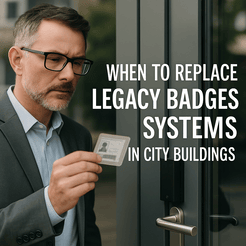
Many government buildings still rely on legacy badge systems—those outdated plastic access cards that were once considered cutting-edge. But as physical and cyber threats evolve, and public expectations shift toward faster, smarter, and more secure facilities, these old systems often become liabilities.
In this article, we explore the signs it’s time to replace your legacy badge system, the risks of holding on too long, and modern solutions that empower cities and counties to take control of access without losing convenience.
k
k
What Is a Legacy Badge System?
A legacy badge system is typically:
-
On-premise software that requires local servers
-
Plastic ID cards or fobs with static credentials
-
Limited credential management with no expiration automation
-
No real-time monitoring or alerts
-
No integration with other systems like HR, visitor management, or surveillance
If your system matches most of the above, you’re likely overdue for an upgrade.
k
k
Why These Systems No Longer Cut It
1. No Real-Time Control
Legacy systems often lack remote capabilities. If an employee loses a badge or gets terminated, revoking access may require a manual process—and doesn’t happen fast enough to prevent breaches.
Modern alternative:
Cloud-based access control platforms allow real-time credential updates, revocations, and activity monitoring from any secure device.
k
k
2. No Integration Across Departments or Buildings
Older badge systems can’t scale across city campuses or departments—resulting in fragmented access policies, duplicate credentials, and inefficient management.
Modern alternative:
Unified platforms support multi-site, multi-user credentialing from a single dashboard. One ID or mobile credential can provide seamless access across all authorized facilities.
k
k
3. Static, Unencrypted Credentials Are Vulnerable to Cloning
Many legacy badges use outdated technology like 125kHz proximity cards, which are easily cloned using inexpensive tools.
Modern alternative:
Upgraded credentials (such as encrypted smartcards, mobile credentials, or biometric integration) are much harder to duplicate and meet higher security standards like FIPS-201 and NDAA compliance.
k
k
4. Lack of Audit Trails and Alerts
With no built-in reporting, legacy systems don’t offer reliable audit trails. If an incident occurs, there's no way to know who accessed what, when, or how.
Modern alternative:
Access logs, real-time alerts, and activity reports give municipalities full visibility for investigations, compliance, and liability protection.
k
k
5. High Maintenance, Limited Support
Older systems often rely on proprietary software or hardware that is no longer supported—making upgrades, patches, and replacements difficult or impossible.
Modern alternative:
SSP’s modern systems are built on open architecture and cloud-based software, ensuring long-term support, automatic updates, and interoperability with future technology.
k
k
Signs It’s Time to Replace Your Badge System
Not sure if now’s the right time? Here are common signs:
-
🔑 You can’t manage credentials remotely
-
🕵️ You lack entry/exit reporting or logs
-
🔒 Employees still use cards with no expiration
-
🧩 Your access system doesn’t integrate with cameras or HR software
-
📉 You’ve experienced a security incident due to outdated access
k
k
What the Upgrade Process Looks Like
Upgrading doesn’t have to mean downtime or disruption. SSP helps government agencies through a phased, budget-conscious transition:
-
Site assessment: Evaluate existing systems, doors, hardware, and risk levels
-
Platform design: Choose a cloud-based, scalable access control system
-
Credential migration: Shift from proximity cards to encrypted or mobile credentials
-
User training: Ensure staff understand how to use the new system effectively
-
Ongoing support: Continuous updates, analytics, and compliance assistance
k
k
Mobile Credentials: The New Standard
More municipalities are adopting mobile credentials as part of their access control modernization. Benefits include:
-
No physical cards to manage or lose
-
Remote provisioning and revocation
-
Multi-factor authentication
-
Lower long-term cost of ownership
Mobile access is not only more secure—it’s more convenient for staff, contractors, and visitors.
k
k
Secure Access Starts with the Right Technology
Holding onto legacy badge systems may seem cost-effective short-term—but the security, compliance, and operational risks far outweigh the benefits. Modernizing your access control means better protection, smarter reporting, and a foundation that scales with your city’s needs.
🔐 Ready to Upgrade?
See how SSP helps government agencies protect their people and infrastructure.


